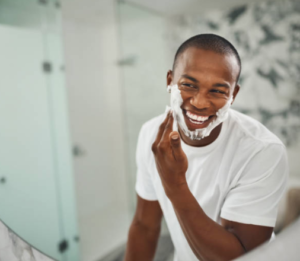If you’ve ever shaved, you probably know how razor bumps feel. Also called shaving bumps, these painful or itchy bumps are caused when shaving irritates the skin. They’re also not a pleasant sight and tend to look even worse on darker skin tones.
“Statistics suggest that men of African descent are more susceptible to razor bumps than other groups, with 45–85% of people affected. This skin issue is also common among Hispanics.” Razor bumps also commonly affect the groin area of females from all populations.
The good news is that changing your habits when shaving can help prevent razor bumps from developing or cause fewer, less painful bumps. Here’s 5 of my top tips to prevent the “Razor Bump Blues”:

1.Shave when your hair is soft. Shaving at the end of your shower or holding a warm, damp washcloth to the area you’d like to shave loosens the hairs and causes them to swell, so they’re less likely to curve into your skin and cause bumps.

2. Use proper technique when shaving to reduce bumps. Shave in the direction your hair grows or you’re training it to grow. Then, rinse the shaving cream off with warm water and place a cool, damp washcloth on your just-shaved skin.

3. Use the right products. Before shaving, wash your skin with a non-comedogenic (won’t clog pores) cleanser. While shaving, always use a moisturizing shaving cream. Once you’re done shaving, apply a soothing aftershave formulated to reduce risk of razor bumps and irritation.

4. Shave more often. Shaving daily, or at least every 2-3 days, gives hair less time to grow and curve.

5. Grow out your hair. Shaving causes razor bumps. If you have the option, stopping shaving and growing out your hair, instead, will help eliminate the cause of your razor bumps.
Finally, take note that razor bumps can create permanent changes when left untreated, like deep grooves and raised scars. If you still get razor bumps after changing your shaving habits, please see a board-certified dermatologist to get relief.






https://shorturl.fm/xvb5b